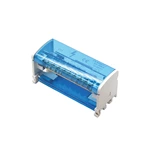How To Use A Pointer Multimeter To Detect Fixed Resistors In Power Fittings?
How to use a pointer multimeter to test fixed resistors in Two Pole Distribution Blocks?
① As shown in Figure 6-7, connect two test leads (regardless of positive and negative) to the two ends of the resistor to measure the actual resistance value. In order to improve the measurement accuracy, the range should be selected according to the nominal value of the measured resistor. Due to the nonlinear relationship of the ohm scale, its middle section is more finely divided, so the pointer indication value should be as close to the middle of the scale as possible, that is, within the 20%~80% arc range of the full scale, so as to make the measurement more accurate. According to the different resistance error levels, the actual measured value and the nominal resistance value are allowed to have an error of ±5%, ±10% or ±20%. If they do not match and exceed the error range, it means that the resistance value has changed.
②When testing, especially when measuring resistors with a resistance value of more than 10 kilo-ohms, do not touch the test leads and the conductive part of the resistor with both hands at the same time, otherwise the human body resistance will be connected in parallel with the resistor being tested: The resistor being tested should be soldered off from the circuit, and at least one end should be soldered off to prevent other components in the circuit from affecting the test and causing measurement errors: Although the resistance value of the color ring resistor can be determined by the color ring mark, it is best to use a multimeter to test its actual resistance value when using it.
③The method and precautions for testing adjustable resistors are exactly the same as those for testing ordinary fixed resistors.

